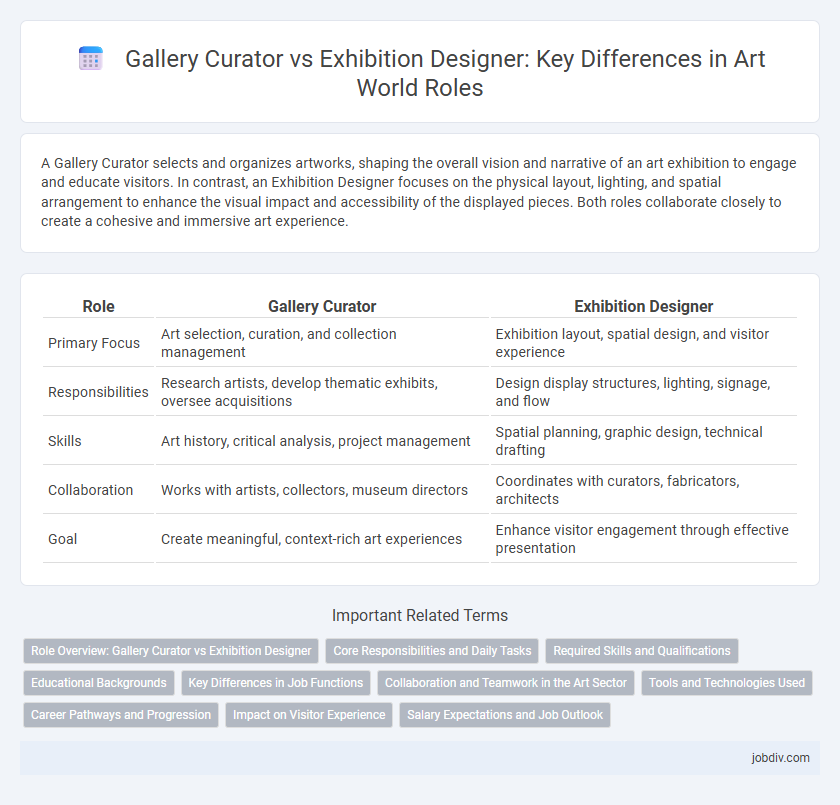A Gallery Curator selects and organizes artworks, shaping the overall vision and narrative of an art exhibition to engage and educate visitors. In contrast, an Exhibition Designer focuses on the physical layout, lighting, and spatial arrangement to enhance the visual impact and accessibility of the displayed pieces. Both roles collaborate closely to create a cohesive and immersive art experience.
Table of Comparison
| Role | Gallery Curator | Exhibition Designer |
|---|---|---|
| Primary Focus | Art selection, curation, and collection management | Exhibition layout, spatial design, and visitor experience |
| Responsibilities | Research artists, develop thematic exhibits, oversee acquisitions | Design display structures, lighting, signage, and flow |
| Skills | Art history, critical analysis, project management | Spatial planning, graphic design, technical drafting |
| Collaboration | Works with artists, collectors, museum directors | Coordinates with curators, fabricators, architects |
| Goal | Create meaningful, context-rich art experiences | Enhance visitor engagement through effective presentation |
Role Overview: Gallery Curator vs Exhibition Designer
Gallery curators oversee the selection, acquisition, and interpretation of artworks, ensuring cohesive narratives that reflect the institution's mission and audience engagement. Exhibition designers focus on the spatial planning, lighting, and installation techniques to create immersive environments that enhance the viewer's experience and highlight artistic elements. Both roles collaborate closely to balance curatorial vision with practical design, optimizing the presentation and impact of art exhibitions.
Core Responsibilities and Daily Tasks
Gallery curators oversee collections, plan exhibitions, and manage acquisitions, focusing on research, artwork selection, and contextual storytelling to enhance visitor engagement. Exhibition designers translate curators' concepts into spatial layouts, integrating lighting, display structures, and multimedia elements to create immersive experiences. Both roles collaborate closely, blending scholarly knowledge with practical design to ensure cohesive and compelling art presentations.
Required Skills and Qualifications
Gallery curators require expertise in art history, strong research skills, and experience in collection management, along with proficiency in developing educational programs and writing grant proposals. Exhibition designers need a background in design principles, spatial planning, and technical skills in lighting, graphics, and multimedia to create engaging, cohesive displays. Both roles demand strong communication abilities and collaboration skills to work effectively with artists, institutions, and the public.
Educational Backgrounds
Gallery Curators typically hold degrees in Art History, Museum Studies, or Fine Arts, emphasizing research, collection management, and interpretive skills. Exhibition Designers often have educational backgrounds in Interior Design, Architecture, or Graphic Design, focusing on spatial planning, visual storytelling, and audience engagement. Both roles require specialized knowledge but differ in academic focus, with curators centered on art curation and scholars and designers on the immersive experience.
Key Differences in Job Functions
Gallery curators oversee the selection, acquisition, and interpretation of artworks, ensuring cohesive thematic presentations that align with the institution's mission and audience engagement goals. Exhibition designers focus on the spatial planning and visual presentation, crafting environments that enhance viewer interaction and highlight the artworks' aesthetic and narrative qualities. While curators drive content and conceptual development, designers translate these ideas into immersive, accessible physical experiences within the gallery or museum space.
Collaboration and Teamwork in the Art Sector
Gallery curators and exhibition designers work collaboratively to create immersive and cohesive art experiences, combining curatorial expertise with spatial and aesthetic design. Effective teamwork involves aligning the curator's vision for artwork selection and narrative with the designer's skills in layout, lighting, and visitor flow to enhance audience engagement. This synergy is crucial in the art sector for producing exhibitions that are both intellectually meaningful and visually compelling.
Tools and Technologies Used
Gallery curators utilize collection management software and digital archives to organize and preserve artworks, while exhibition designers rely on 3D modeling software and CAD tools to create immersive spatial layouts. Curators often use database systems for provenance research and metadata tagging, enhancing artwork accessibility and scholarly study. Exhibition designers integrate virtual reality (VR) and lighting simulation technologies to optimize visitor experience and visual impact within gallery spaces.
Career Pathways and Progression
Gallery curators typically progress from roles as assistant curators or art historians, building expertise in collection management, research, and public programming, while exhibition designers often start with backgrounds in graphic or interior design, focusing on spatial planning and visual storytelling. Career advancement for curators leans toward senior curatorial positions or museum directorships, emphasizing expertise in art history and collection strategy. Exhibition designers advance by mastering innovative display technologies and project management, leading to roles such as lead exhibition designer or creative director within galleries and museums.
Impact on Visitor Experience
Gallery curators shape visitor experience by selecting and contextualizing artworks, crafting narratives that deepen engagement and understanding. Exhibition designers influence how visitors interact physically with the space, using layout, lighting, and materials to evoke emotional responses and guide movement. Together, their collaboration creates immersive environments that enhance aesthetic appreciation and educational impact.
Salary Expectations and Job Outlook
Gallery curators typically earn between $50,000 and $75,000 annually, with potential growth linked to experience and gallery prestige, while exhibition designers command salaries ranging from $45,000 to $80,000 based on project scope and design expertise. Job outlook for gallery curators includes steady demand in museums and art institutions, driven by a need for expertise in art curation and collection management. Exhibition designers face increasing opportunities due to the rising emphasis on immersive and interactive art displays, cultivating vibrant visitor experiences in galleries and museums.
Gallery Curator vs Exhibition Designer Infographic

 jobdiv.com
jobdiv.com